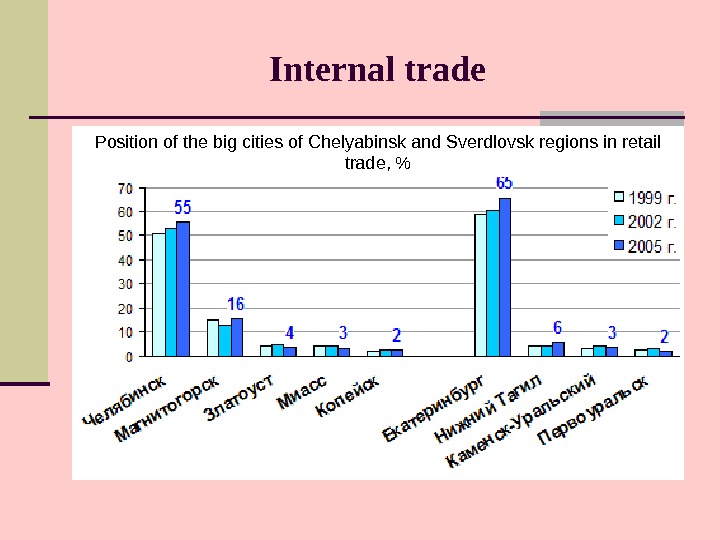Chelyabinsk region: economical and geographic portrait of the










































economical_and_geographical_portrait.ppt
- Размер: 6.7 Mегабайта
- Количество слайдов: 41
Описание презентации Chelyabinsk region: economical and geographic portrait of the по слайдам
 Chelyabinsk region: economical and geographic portrait of the region © Pavel Degtyarev. ,
Chelyabinsk region: economical and geographic portrait of the region © Pavel Degtyarev. ,
 Factors of territory development « That doesn’t depend on us » « That depend on us »
Factors of territory development « That doesn’t depend on us » « That depend on us »
 Subsystems of the region
Subsystems of the region
 Region: in brief Square – 88, 5 (0, 5 %) А – 83, 8 Population – 3, 5 (2, 5 %) А – 8, 4 Gross regional product – 650, 0 (2 %)
Region: in brief Square – 88, 5 (0, 5 %) А – 83, 8 Population – 3, 5 (2, 5 %) А – 8, 4 Gross regional product – 650, 0 (2 %)
 Geographical location
Geographical location
 Territory Features : 1. Efficiency. 2. Relative size. 3. Relative location . 4. Integrity. 4. Saturation. 5. Structure.
Territory Features : 1. Efficiency. 2. Relative size. 3. Relative location . 4. Integrity. 4. Saturation. 5. Structure.
 Natural conditions 20 % — mountain territory Almost comfortable territory Periodical draughts Spring’s big water Geochemical anomaly Infected territory
Natural conditions 20 % — mountain territory Almost comfortable territory Periodical draughts Spring’s big water Geochemical anomaly Infected territory

 Territory: bronze age
Territory: bronze age
 Territory: early new time
Territory: early new time
 Territory: 18 -19 th centuries
Territory: 18 -19 th centuries
 Time – main resource of economical development Chelyabinsk region (250 лет) Verkhneuralsk , 1735 год Austria (2 000 лет) Vindbona ( Vienna ), 90 A. D.
Time – main resource of economical development Chelyabinsk region (250 лет) Verkhneuralsk , 1735 год Austria (2 000 лет) Vindbona ( Vienna ), 90 A. D.
 Development based on forced labour Крепостное право ↓ Peasants fixed to the factories Soviet economy ↓ GULAG
Development based on forced labour Крепостное право ↓ Peasants fixed to the factories Soviet economy ↓ GULAG
 Dynamics of populations
Dynamics of populations
 Demographic features Negative : Population decrease ( from 1992) High death rate ( especially, men ) Increase of old population Disproportion between sexes Reducing numbers of marriges
Demographic features Negative : Population decrease ( from 1992) High death rate ( especially, men ) Increase of old population Disproportion between sexes Reducing numbers of marriges
 Low density of population (40 p / sq. km. ) ↓↓↓ 1. « Small » market. 2. Low infrastructure saturation 3. Long pay back period of capital investment. 4. ‘Wild’ territory. 5. Slow market exchange.
Low density of population (40 p / sq. km. ) ↓↓↓ 1. « Small » market. 2. Low infrastructure saturation 3. Long pay back period of capital investment. 4. ‘Wild’ territory. 5. Slow market exchange.
 Polyethnic structure
Polyethnic structure
 Employment
Employment
 Unemployment – how to use labour force
Unemployment – how to use labour force
 Income per capita – about 400 euro
Income per capita – about 400 euro
 Growth of social differentiation Poor – 20 % 5 % gross income Rich – 20 % 50 % gross income
Growth of social differentiation Poor – 20 % 5 % gross income Rich – 20 % 50 % gross income
 Social segregation For poor people For rich people
Social segregation For poor people For rich people
 Ideal settlement of population
Ideal settlement of population
 Actual settlement of population
Actual settlement of population
 Perspective settlement – concentration in the basic points of the region
Perspective settlement – concentration in the basic points of the region
 Urbanization – 82 % Magnitogorsk from space. Map of Zlatoust
Urbanization – 82 % Magnitogorsk from space. Map of Zlatoust
 Each second town is monotown
Each second town is monotown
 Rural – 18 % of population
Rural – 18 % of population
 Mono-industry structure of economy Structure of production of Chelyabinsk region, % Metallurgy Food industry Machinery industry Mineral products Electrical equipment Leathers things Wood and things made from wood
Mono-industry structure of economy Structure of production of Chelyabinsk region, % Metallurgy Food industry Machinery industry Mineral products Electrical equipment Leathers things Wood and things made from wood
 Traditional energetics
Traditional energetics
 Ferrous metallurgy → income of budget Foundry of Kasli. Geography of ferrous metallurgy enterprises
Ferrous metallurgy → income of budget Foundry of Kasli. Geography of ferrous metallurgy enterprises
 Non-ferrous metallurgy – dependency of international conjuncture Dynamic of copper prices, thousands $ per ton
Non-ferrous metallurgy – dependency of international conjuncture Dynamic of copper prices, thousands $ per ton
 Degrading of machinery building industry
Degrading of machinery building industry
 Food security – about 60 % Periphery – extensive (grain) 1. Low yields 2. Non-efficiency land tenure 3. Depletion of soil fertility (richness). Suburban — intensive
Food security – about 60 % Periphery – extensive (grain) 1. Low yields 2. Non-efficiency land tenure 3. Depletion of soil fertility (richness). Suburban — intensive
 Internal trade Position of the big cities of Chelyabinsk and Sverdlovsk regions in retail trade, %
Internal trade Position of the big cities of Chelyabinsk and Sverdlovsk regions in retail trade, %
 Инфраструктура
Инфраструктура
 Trade between regions of Russia ,
Trade between regions of Russia ,
 International relations More than 120 countries 1 600 companies Positive trade balance Semi-food export (-) Raw material import (-) Dominance of long distance relations (-) Outbound tourism (-)
International relations More than 120 countries 1 600 companies Positive trade balance Semi-food export (-) Raw material import (-) Dominance of long distance relations (-) Outbound tourism (-)
 Bipolar organization of regional economy Chelyabinsk + Magnitogorsk = 50 % of population , 70 % retail trade and 80 % industries’ production
Bipolar organization of regional economy Chelyabinsk + Magnitogorsk = 50 % of population , 70 % retail trade and 80 % industries’ production
 Main problems Development based on inertia (persistence) Market without competition
Main problems Development based on inertia (persistence) Market without competition


